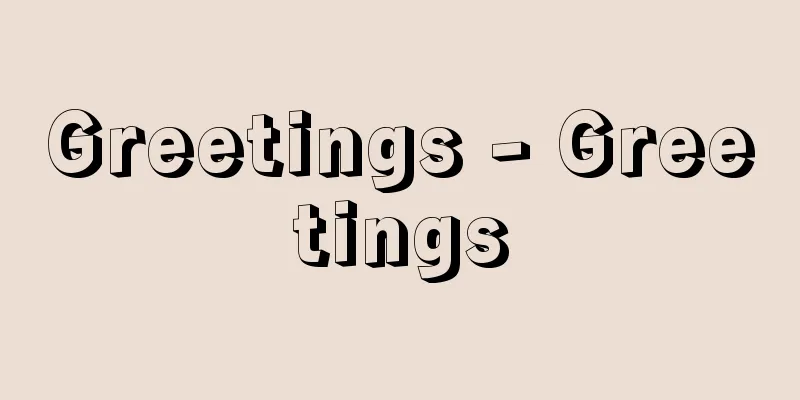Greetings - Greetings

|
It is a formal, almost ritualistic interaction that facilitates daily human relationships. On the other hand, it can also be used to alienate people. There are various ways to greet each other, such as calling out to each other or showing specific facial expressions and gestures, and these words and actions are taught from an early age in each society. Since greetings also have the purpose of positioning or confirming one's relationship with others in the social space, the way of greeting varies depending on various conditions such as gender, age, position, status, religion, the presence or absence of kinship or difference, and whether one is inside or outside the living group. For example, when a Bedouin tribe living in the desert of Saudi Arabia visits the tents of other tribes, they only shake hands with the men of the tribe. If they are visiting from the same tribe and the person is of the same lineage (a group of people with a single lineage) and is up to about 30 years old, they greet with a light kiss. If they are middle-aged or older or of a different lineage, they touch their nose with their fingers two or three times. If the person is elderly and of a different lineage, they simply touch their nose with their fingers, but if they are of the same lineage, they kiss their nose. On the other hand, when visiting women, if they are of a different lineage and are not related by marriage, they simply speak to them through the partition in the tent. However, if they are of the same lineage, they enter the women's section and, depending on the difference in lineage, they shake hands or lift their veil and kiss them on the cheek. Other unusual greetings include the Masai and other cattle herders of East Africa who stick their spears upside down into the ground, and the Moni in the New Guinea highlands who say "Amakane" and make a pinky promise to each other, pulling and releasing, making a snapping sound to show familiarity. Many individual examples, such as the special greetings given by the Eskimos with big smiles on their faces, are introduced in travelogues and ethnographies. However, when it comes to greetings among ethnic groups, especially non-Western societies, there is a strong tendency to focus on only the peculiar aspects and make them a topic of discussion. However, depending on one's viewpoint, the Japanese bowing at the waist and Westerners hugging and kissing may be perceived as unusual greetings. When considering greetings, it is necessary to dig deeper, comparing and relating the social circumstances and cultural assumptions behind them. [Masayoshi Ogawa] Japanese greeting methodJapanese greetings are also a way of responding before and after face-to-face negotiations, and are usually accompanied by traditionally formalized "word usage" and specific "gestures." "Ai" in "greeting" means to push and "satsu" means to push back, and originally referred to the "response" in the "chishiki sougen" (conceived knowledge and ideas) of Zen monks, and have come to be used in general. In Japanese, it has long been customary to say "monoii" (to speak), "kotoba kaeru" (to speak to), or "koe kaeru" (to speak to), and the phrases used in Kyogen to respond with "nante" (to speak) are similar. These ways of responding have been standardized and passed down in the "rituals" of Yusoku Kojitsu, but it is more important to emphasize the customs of the general public, and their styles are extremely diverse depending on the region and occupation, and they have also changed significantly over time. Greeting styles are divided into "in-group" and "out-group" and there are also big differences between everyday (ke) and special, formal occasions (hare). Everyday greetings are "formal terms" related to common interests such as the weather and progress of work, and differ according to the season and time of day. Early morning greetings are common, but there are also various regional examples such as ohin-nari and tadaima. For daytime greetings, some regions use greetings such as osendosan and goshodashi, which are used to praise the other person's work. Also, greetings related to rest and meals such as oagari and nomanshitaka, and evening greetings such as otsukare, obande, and oshimaina often show appreciation for work. Nighttime greetings are also synonymous, and dialects such as oizato, daccho, and zattoya retain the old meaning of "be alert." There are also fixed terms for visiting other people's homes and when meeting someone for the first time, and these, too, are often specialized according to region or occupation. From Uchina and Irashinsuke, which are used to ask if a family member is present, to Oyurushina and Goyosha, which are equivalent to today's Gomenkudasai, many words were used, and further formalized abbreviations such as Haitto, Yoito, and Oiron were created. "Momono" (to submit) is also an old form of abbreviation, and today it remains in the word Moshimoshi when answering the phone. There are also many different "farewell words" such as Sayonara and Sonnara, and many of them, such as Matana, Omyonichi, Kondomeya, and Sondehamata, are used to promise to meet again. Daily greetings among friends have become increasingly simplified, and it is not uncommon for them to have become complete codes, but they are still sufficient to confirm a relationship. For New Year's greetings, Bon Festival, seasonal festivals, and visits to mark good or bad luck, there are formal customary greetings, and in some places even old forms accompanied by "kojo-gaki" remain. Greetings when "joining" a group differ depending on the profession, but they are generally solemn, and when it comes to so-called "introduction" greetings, they are usually highly stylized. The "introduction speech" of kabuki actors is a typical example, and the "introduction" of "yakuza" friends is also solemn, and a separate etiquette style called "jingi wo kiru" has also emerged as a greeting for non-members. It is generally believed that greetings often include magical blessings, but in Japan this is weak, with only a small trace of praise for gods and Buddhas remaining in words of thanks such as toudeya and arigatou. The gestures of greeting are diverse, and although they are simplified in everyday situations, they are stylized in various ways for specific occasions. According to the Gishiwajinden, when a non-drinker meets an adult, he or she steps back, crouches down, bows on both hands, and responds by saying "Ai" (sigh), or in a public place, responds to an adult's bow by clapping both hands. This conveys an ancient form, but at least in Japan, the traditional style is to "bow the head," and the style is different for standing and seated bows. In particular, the use of a fan has led to the creation of various forms of seated bows at special occasions. [Toshimi Takeuchi] Source: Shogakukan Encyclopedia Nipponica About Encyclopedia Nipponica Information | Legend |
|
日常の人間関係を円滑に取り運ぶための、一定の形式をもった、なかば儀礼的な相互行為。一方、人間関係を疎遠にするために交わすこともある。 挨拶の方法は、互いに声をかけあったり、または特定の顔の表情や身ぶり手ぶりで示すなどさまざまであり、これらのことばや動作は、それぞれの社会において幼いころからしつけられる。また挨拶には、社会的空間において互いの関係を位置づけまたは確認するという目的も含まれているため、性、年齢、地位、身分、宗教、親族関係の有無あるいは差違、生活集団の内にあるか外にあるかなどの諸条件に応じて挨拶の仕方も違ってくる。 たとえば、サウジアラビアの砂漠に住むベドウィンのある部族は、他部族のテントを訪れたとき、彼らのうちの男たちとだけ握手を交わす。訪問先が同一部族であって、相手が30歳くらいまでの同じリネージ(単系出自集団の一つ)であれば、軽い口づけを挨拶とする。中年以上、または別のリネージの者に対しては、相手の鼻に2~3回指を触れる。また相手が老人の場合は、リネージが異なれば単に指を鼻に触れるだけだが、リネージが同じなら鼻に接吻(せっぷん)をする。一方、女たちに対しては、リネージが異なり姻戚(いんせき)でもなければ、テント内の仕切り越しにことばをかけるだけである。しかし同リネージの場合は、女の区画へ入って行き、リネージの差異により握手あるいはベールを上げて頬(ほお)に接吻をする。 このほか、変わった挨拶として、マサイなど東アフリカの牛牧民は地面に槍(やり)を逆さまにして突き刺すし、ニューギニア高地のモニなどは「アマカネ」といいながら指切りのようなことをして互いに引っ張って離し、パチンと音をたてることで親しみを表現する。またエスキモーによる満面笑みをたたえた特別の応対ぶりなど、個々の事例は旅行記や民族誌で多く紹介されている。 しかし、諸民族とりわけ非西欧的社会における挨拶については、風変わりな部分だけが取り上げられ、ことさら話題にされる傾向が強い。だが、日本人が腰を折り身をかがめておじぎをし、欧米人が抱擁し接吻するのも、みる立場によっては、それぞれ変わった挨拶として受け止められよう。挨拶を考える場合、その背景にある社会的状況と文化的前提とを対比、関連させながら掘り下げる必要があろう。 [小川正恭] 日本人の挨拶方式日本人の挨拶も対面交渉の前後に行われる応対方式であって、通例伝統的に形式化した「ことば遣い」に特定の「身ぶり」を伴う。挨拶の「挨」は押す、「拶」は押し返すの意で、本来は禅僧の「知識考案」における「受け答え」をさす語で、それが一般にも通用するに至ったもの。国語では古くから「物言い」あるいは「ことばをかける」「声をかける」などと言い習わし、狂言において応対文句に「何と」「物と」とあるのも同趣である。こうした応対方式は有職(ゆうそく)故実の「礼式」などに定型化されて伝存するが、むしろ民間一般の習俗が重視されるべきで、地方性と職業に従ってその様式は多様を極め、また時代による変遷も顕著である。 挨拶の方式は「仲間内」と「仲間外」の別があり、また日常時(ケ)と特定の改まった場合(ハレ)とでは大きな違いが生ずる。日常の挨拶ことばは、天候や仕事の進度など共通の関心にかかわる「形式的用語」であり、季節や時刻で異なる。早朝のオハヨウは一般的であるが、このほかオヒンナリ、タダイマというような地方的用例もいろいろある。日中のコンニチハにも、オセンドサン、ゴショウダシなど、相手の働きぶりを褒める意味の挨拶ことばを用いる地方もある。また、オアガリ、ノマンシタカなど休息、食事にかかわるものや、オツカレ、オバンデ、オシマイナなど夕刻の挨拶には労働のねぎらいを示すことばが多い。夜のオヤスミも同義で、オイザト、ダッチョ、ザットヤーなどの方言には「目ざとくあれ」という古意が残っている。 他家訪問や初対面の応対にも定型の用語があり、これらもまた地方的、職業的に特殊化した例が少なくない。ウチナ、イラシンスケなど家人の在否を尋ねる形から、オユルシナ、ゴヨウシャなど、今日のゴメンクダサイと同意の語が多く用いられ、さらに形式化してハイット、ヨイト、オイロンといった簡略語も生まれた。「物申(も)う」も簡略語の旧形で、現在は電話応対のモシモシに名残(なごり)をとどめている。サヨナラ、ソンナラという「別れことば」も多岐にわたり、マタナ、オミョウニチ、コンドメヤ、ソンデハマタなど再会を約す意味のものが多い。仲間内の日常挨拶ことばは簡略化が進み、まったくの符丁と化したものも珍しくはないが、それでも仲間関係の確認には足りるのである。 正月礼、盆礼、節供礼や吉凶の訪問には、改まった慣習的挨拶ことばがあり、所によっては「口上書(こうじょうがき)」を伴う古形式さえ残っている。また、「仲間入り」の挨拶は職業によって違うが、おおむね重々しく、いわゆる「披露」の挨拶ともなると多分に様式化されるのを常とした。歌舞伎(かぶき)役者の「披露口上」などはその典型であり、また「やくざ仲間」の「披露」もものものしく、別に仲間外挨拶として「仁義をきる」という作法様式も生じた。 一般に挨拶には呪術(じゅじゅつ)的祝福の意を伴うことが多いとされているが、日本の場合はそれが希薄で、わずかにトウデヤ、アリガトウなどの「礼ことば」に神仏をたたえる意が若干残る程度である。 挨拶の「身ぶり」は多様で、日常の場合は簡略化されたものの、特定の席ではさまざまに様式化した。『魏志倭人伝(ぎしわじんでん)』によれば、下戸(げこ)が大人(たいじん)に会うと退いてうずくまり、両手をついてかしこまり、「噫(あい)」と返答するとか、あるいは公の場にあって大人の礼拝に両手を打って応ずる、とある。これは古形を伝えるものだが、少なくとも日本においては「頭を下げる」ことが伝統的様式であり、立礼と座礼ではその様式も異なる。とくに「ハレ」の席の座礼にあっては、扇の使用によってさまざまの形を生み出すことにもなった。 [竹内利美] 出典 小学館 日本大百科全書(ニッポニカ)日本大百科全書(ニッポニカ)について 情報 | 凡例 |
>>: Aisa (Akisha) - Aisa (English spelling) merganser
Recommend
People's Theatre
A German theater-going group and its theater. Infl...
Haarlemmermeer
...The North Sea dunes in the west of the city ar...
Jasminum nudiflorum (English spelling)
…[Murata Gen]. … *Some of the terminology that me...
aoidē (English spelling) aoide
…It is a genre of poetry generally understood tod...
Stochastic differential equations
A differential equation that deals with quantities...
Niterói - Niteroi (English spelling)
A city in the state of Rio de Janeiro in southeas...
Dendrobium densiflorum (English spelling) Dendrobium densiflorum
…[Koichi Ejiri]. … *Some of the terminology that ...
Unohana pickles - Unohana pickles
…The name appears in the August entry of the 53rd...
Kakimiga - Kakimiga
...They overwinter as mature larvae and pupate th...
Kawagoe
...It stretches from the northern end of the Musa...
Moll, A. (English spelling) MollA
...Originally a Latin word meaning strong "d...
Aohori
A district of Futtsu City in the southwest of Chi...
Tongguk-t'onggam (English: Tongguk-t'onggam)
A Korean history book. 56 volumes, 1 volume of the...
Jacques Audiberti
1899‐1965 French playwright. He started out as a j...
cause
...The Massif Central also contains volcanic land...









